
Healthcare bills can be especially problematic to navigate and even harder to fully understand, even for the most seasoned consumers. Multiply any singular confusion by the three in four U.S. consumers who paid for healthcare products or services in the past 12 months, and that’s hundreds of millions of potential headaches.
PYMNTS’ latest collaboration with Lynx, “The Digital Platform Promise: How Patients Want to Streamline Healthcare Payments,” focuses on digital platforms’ role in the payment of healthcare products and services. The research found that 29% of consumers used a digital portal at least once to pay a medical bill in the past year, and one-quarter of those who used a digital portal to pay during that period say it is their preferred way to pay.
Unfortunately, like many checkout processes, paying for healthcare products and services can involve friction.

Over half of the consumers — 54% — experienced pain points for services and items related to healthcare. Further highlighting the need for a more seamless experience overall, 21% reported having difficulty with the payment process, and nearly as many had difficulty understanding their bills and keeping track of their credentials. Online portals are useful in that respect, with 25% of consumers holding an account with one reporting the platform helped make it easier to access account information.
This presents a challenge for all parties involved. For the patient, paying a bill they don’t understand is an invitation for further friction. And, as previous PYMNTS research has found, consumers tend to prioritize the bills they find least friction-filled.
One solution that could empower bill-paying patients and possibly raise the chances of on-time payments may be found in taking a cue from the banking sector. Namely, offering educational tips or pointers through a healthcare company’s digital portal to send consumers their bills to clarify the process. A connection has been made between basic financial literacy, which hovers at 4% in the U.S., and younger generations relying on digital tools supplied by financial institutions. This kind of education may assist banks by cementing customer loyalty towards an institution regarded as trustworthy. It stands to reason this loyalty may extend to other billing entities as well.
Consumer education by healthcare billers may be as simple as an optional walkthrough of a bill’s components explaining charges and other details. And the benefits, in both possible increased on-time bill pay and customer retention, may make any investment in education reap healthy returns.